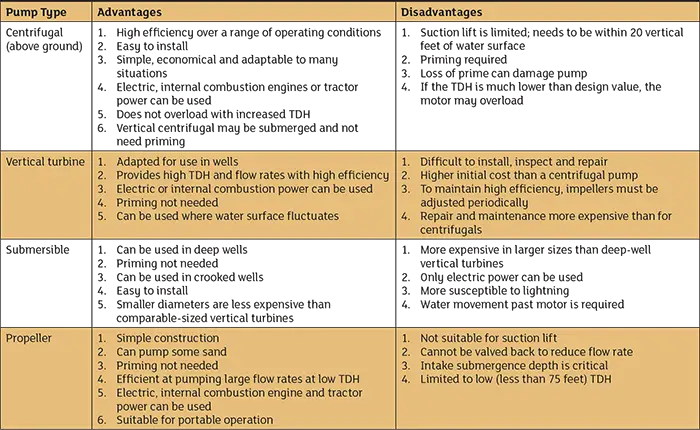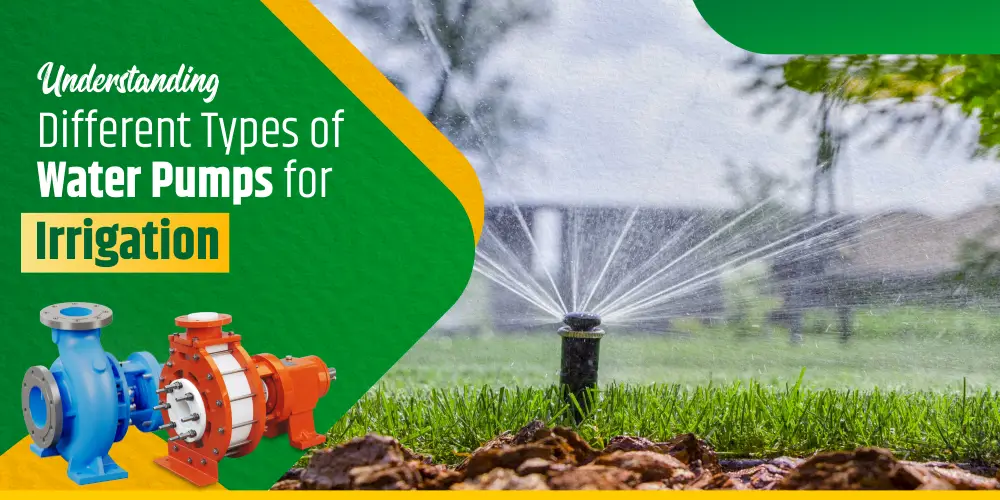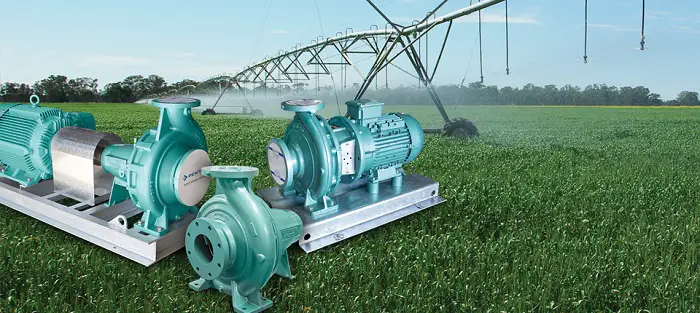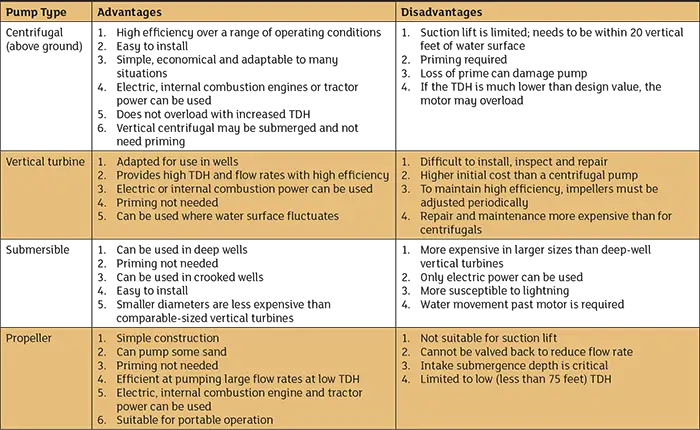This post may contain affiliate links which means I may receive a commission for purchases made through links. Learn more on my Private Policy page.
Are you in need of an irrigation pump but feeling overwhelmed by the number of options available? Look no further! In this article, we will give you a brief overview of the different types of irrigation pumps and provide you with some helpful tips on how to choose the right one for your specific needs. So whether you’re a seasoned gardener or just starting out, we’ve got you covered!
Centrifugal Pumps
Centrifugal pumps are commonly used in irrigation systems due to their efficiency and ability to handle large volumes of water. These pumps work by converting rotational energy from an impeller into kinetic energy to move the water. There are several subtypes of centrifugal pumps that you can choose from depending on your specific irrigation needs.
Single-Stage Centrifugal Pumps
Single-stage centrifugal pumps are ideal for applications where low to moderate pressure is required. They have a single impeller that creates the necessary force to move water. These pumps are often used in small-scale irrigation systems where the water source is not too far away and the required pressure is relatively low.
Multi-Stage Centrifugal Pumps
Multi-stage centrifugal pumps are suitable for irrigation systems that require higher pressure. These pumps have multiple impellers that work together to generate greater force, enabling them to push water over longer distances and to higher elevations. They are commonly used in large-scale agricultural irrigation systems where water needs to be transported over extensive lengths.
Submersible Centrifugal Pumps
Submersible centrifugal pumps are designed to be submerged in water, making them an excellent option for irrigation systems that draw water from wells or other underground sources. These pumps are placed directly in the water source, eliminating the need for suction pipes and reducing the risk of priming issues. They are generally more efficient and require less maintenance compared to other types of centrifugal pumps.
Self-Priming Centrifugal Pumps
Self-priming centrifugal pumps are a convenient choice for irrigation systems that require easy installation and operation. These pumps are designed to automatically prime themselves, meaning they can start pumping water without the need for external priming. This feature is particularly useful in situations where the water source may not always be readily available or where frequent restarts are necessary.
Positive Displacement Pumps
Positive displacement pumps work by trapping a specific amount of water and then forcing it out through a discharge pipe. These pumps are suitable for various irrigation applications and can handle fluids with varying viscosities. They can be further divided into different subtypes based on their operating mechanisms.
Reciprocating Pumps
Reciprocating pumps operate by using a piston or plunger to move water back and forth. As the piston or plunger moves in one direction, it creates a vacuum that draws in water, and as it moves in the opposite direction, it compresses the water, pushing it out through the discharge pipe. These pumps are capable of delivering high pressures and are often used in applications where precision is required.
Rotary Pumps
Rotary pumps use rotating mechanisms, such as gears or lobes, to move water. They are known for their smooth and continuous flow and can handle various types of fluids, including those with solid particles. Rotary pumps are durable and reliable, making them suitable for both small-scale and large-scale irrigation systems.
Diaphragm Pumps
Diaphragm pumps utilize a flexible diaphragm that moves back and forth to pump water. These pumps are versatile and can handle fluids with high levels of solids or chemicals. They are commonly used in applications that require precise control over the flow rate, such as drip irrigation systems.
Peristaltic Pumps
Peristaltic pumps operate by squeezing a flexible tube to create a moving seal that pushes water through. These pumps are gentle on the fluid being pumped, making them ideal for delicate operations or situations where the water quality needs to be preserved. They are often used in applications such as hydroponics or livestock watering systems.

This image is property of www.sintechpumps.com.
Axial Flow Pumps
Axial flow pumps are characterized by their ability to move large volumes of water at relatively low pressures. These pumps work by using an impeller that generates a helical flow pattern, continuously propelling the water in a linear direction along the axis of the pump. Axial flow pumps are commonly used in irrigation systems that require water to be moved over long distances or to cover large areas.
Vertical Axial Flow Pumps
Vertical axial flow pumps are installed vertically, with the impeller located at the bottom. This configuration allows for the pump to operate without the need for priming and minimizes the risk of airlocks. These pumps are often used in irrigation applications that require water to be lifted from lower elevations or pumped from underground sources.
Horizontal Axial Flow Pumps
Horizontal axial flow pumps are designed with a horizontal shaft and an impeller that is set parallel to the ground. These pumps are commonly used in irrigation systems that require water to be transported over longer distances horizontally. Horizontal axial flow pumps are known for their high flow rates and are often used in flood irrigation or large-scale agricultural irrigation.
Mixed Flow Pumps
Mixed flow pumps combine characteristics of both axial flow and centrifugal pumps, making them suitable for a wide range of irrigation applications. These pumps work by generating a combination of radial and axial flow patterns to move water. They can handle both high flow rates and moderate pressures.
Vertical Mixed Flow Pumps
Vertical mixed flow pumps are similar to vertical axial flow pumps; however, they incorporate a slight change in the impeller design to produce a combination of both axial and radial flow patterns. These pumps are often used in situations where higher pressures are required while maintaining a significant flow rate. Vertical mixed flow pumps are commonly found in irrigation systems that involve large farms or golf courses.
Horizontal Mixed Flow Pumps
Horizontal mixed flow pumps are designed with a horizontal shaft and a specially engineered impeller to achieve a mixed flow pattern. These pumps are typically used in irrigation systems that require water to be transported over long distances horizontally, while also generating enough pressure for efficient irrigation. Horizontal mixed flow pumps are a popular choice for large-scale agricultural irrigation or flood irrigation projects.

This image is property of www.pumpsandsystems.com.
Jet Pumps
Jet pumps utilize a high-velocity fluid to create suction and draw water from a well or other water sources. They are often used in situations where the water source is deep and requires significant force to be lifted to the surface. Jet pumps can be further categorized into shallow well and deep well jet pumps.
Shallow Well Jet Pumps
Shallow well jet pumps are designed for water sources that are no deeper than 25 feet. These pumps are typically installed above ground and use a single pipe system to draw water. Shallow well jet pumps are commonly used in residential or small-scale irrigation systems where the water source is relatively close and does not require extensive lifting.
Deep Well Jet Pumps
Deep well jet pumps are suitable for water sources that are deeper than 25 feet. These pumps use a two-pipe system, with one pipe drawing water and the other allowing pressurized air to create suction. Deep well jet pumps are commonly used in agricultural irrigation systems or large-scale commercial applications where water needs to be lifted from significant depths.
Turbine Pumps
Turbine pumps are known for their high efficiency and are often used in irrigation systems that require large volumes of water to be moved over long distances. These pumps work by utilizing a rotating impeller or rotor to generate flow and pressure. Turbine pumps can be categorized into vertical and horizontal configurations.
Vertical Turbine Pumps
Vertical turbine pumps are designed with a vertical shaft and an impeller that is submerged in the water source. These pumps are commonly used in situations where the water source is deep, such as wells or reservoirs. Vertical turbine pumps are capable of delivering high flow rates and pressures, making them suitable for large-scale agricultural or industrial irrigation projects.
Horizontal Turbine Pumps
Horizontal turbine pumps have a horizontal shaft and are typically installed above ground. The impeller is positioned above the water level, and a suction pipe draws water from the source. These pumps are often used in irrigation systems that require water to be transported over long distances horizontally. Horizontal turbine pumps are efficient and reliable, making them popular for various irrigation applications.

This image is property of www.kdpumps.co.uk.
Submersible Pumps
Submersible pumps are designed to be fully submerged in the water source and are ideal for irrigation systems that draw water from wells or other underground sources. These pumps are durable and efficient, providing reliable performance in demanding conditions.
Deep Well Submersible Pumps
Deep well submersible pumps are specifically designed to lift water from deep wells or boreholes. These pumps are submerged in the water source, eliminating the need for priming and simplifying the installation process. Deep well submersible pumps are often used in agricultural irrigation systems or applications that require water to be pumped from significant depths.
Sump Pumps
Sump pumps are used to remove excess water from low-lying areas, such as basements or crawl spaces. These pumps are typically installed in a sump pit or basin and automatically activate when the water level reaches a certain point. Sump pumps are essential for preventing flooding and water damage and can be used in conjunction with other irrigation pumps to manage excess water effectively.
Solar-Powered Pumps
Solar-powered pumps harness the energy from the sun to power irrigation systems. They are an environmentally friendly and cost-effective solution for remote locations or areas with limited access to electricity.
Photovoltaic Solar Pumps
Photovoltaic solar pumps use solar panels to convert sunlight into electricity, which is then used to power the pump. These pumps are highly efficient and reliable, providing a consistent source of energy for irrigation systems. Photovoltaic solar pumps are commonly used in agricultural irrigation, especially in areas with abundant sunlight.
Solar Thermal Pumps
Solar thermal pumps utilize solar energy to heat a fluid, which creates pressure to move water. These pumps are effective in areas with ample sunlight and a need for heating water before irrigation. Solar thermal pumps are commonly used in greenhouse irrigation systems, where maintaining a certain temperature is crucial for plant growth.

This image is property of www.jeepumps.com.
Choosing an Irrigation Pump
Selecting the right irrigation pump is essential for maximizing the efficiency and effectiveness of your irrigation system. Here are some factors to consider when choosing a pump:
Determine Water Source
Identify the water source for your irrigation system, whether it is a well, pond, river, or another underground or aboveground source. The type of pump you choose will depend on the characteristics of your water source.
Calculate Required Flow Rate and Pressure
Determine the flow rate and pressure required for your irrigation system. Consider the size of your irrigation area and the specific water demands of your crops or plants. This information will help you select a pump that can deliver the necessary flow rate and pressure.
Consider the Pump’s Efficiency
Evaluate the efficiency of the pump you are considering. Look for pumps with high efficiency ratings, as they will consume less energy and lower your operating costs in the long run. Efficiency is particularly crucial if you are using a solar-powered pump or operating the pump for extended periods.
Assess Power Requirements
Determine the power requirements for your pump. Consider the availability of electricity or the suitability of solar power in your location. Ensure that your power source can provide the necessary energy for the pump to operate effectively.
Choose the Pump Type
Take into account the different pump types discussed above and their suitability for your specific irrigation needs. Consider factors such as the distance water needs to be transported, the required pressure, the water source characteristics, and the flow rate demands of your irrigation system.
Evaluate Maintenance Requirements
Consider the maintenance requirements of the pump you are considering. Some pumps may require regular maintenance or have specific service intervals. Assess your ability to perform necessary maintenance tasks or budget for professional maintenance services.
Budget and Cost Considerations
Establish a budget for your irrigation pump and consider the upfront costs as well as the ongoing operational costs. Compare the prices of different pump options and weigh them against their performance, reliability, and energy efficiency. Keep in mind that investing in a high-quality pump upfront may result in long-term cost savings.
Consult Experts or Professionals
If you are unsure which irrigation pump is best suited for your needs, consider consulting with irrigation experts or professionals. They can assess your specific requirements and provide guidance on the most suitable pump for your irrigation system.
Conclusion
Choosing the right irrigation pump is crucial for the success of your irrigation system. With a wide range of pump types available, including centrifugal pumps, positive displacement pumps, axial flow pumps, mixed flow pumps, jet pumps, turbine pumps, submersible pumps, and solar-powered pumps, there is a solution for every irrigation need. By considering factors such as water source, flow rate, pressure, efficiency, power requirements, maintenance, budget, and seeking expert advice when needed, you can select the perfect pump to keep your irrigation system running smoothly, efficiently, and effectively. Remember, a well-chosen pump will ensure that your plants receive the water they need, leading to healthy growth and optimal yields.

This image is property of pumps-africa.com.
This post may contain affiliate links which means I may receive a commission for purchases made through links. Learn more on my Private Policy page.

